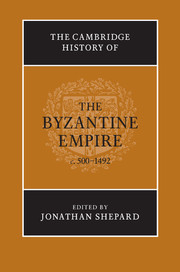Book contents
- Frontmatter
- General Introduction
- Part I The Earlier Empire c. 500–c. 700
- Part II The Middle Empire c. 700–1204
- 5 State of Emergency (700–850)
- 6 After Iconoclasm (850–886)
- 7 Religious Missions
- 8 Armenian Neighbours (600–1045)
- 9 Confronting Islam: Emperors Versus Caliphs (641–c. 850)
- 10 Western Approaches (700–900)
- 11 Byzantine Italy (680–876)
- 12 The Middle Byzantine Economy (600–1204)
- 13 Equilibrium to Expansion (886–1025)
- 14 Western Approaches (900–1025)
- 15 Byzantium and Southern Italy (876–1000)
- 16 Belle Époque or Crisis? (1025–1118)
- 17 The Empire of the Komnenoi (1118–1204)
- 18 Balkan Borderlands (1018–1204)
- 19 Raiders and Neighbours: The Turks (1040–1304)
- Part III The Byzantine Lands in the Later Middle Ages 1204–1492
- Glossary (Including some Proper Names)
- Genealogical Tables and Lists of Rulers
- List of alternative place names
- Bibliography
- Picture Acknowledgements
- Index
- References
18 - Balkan Borderlands (1018–1204)
from Part II - The Middle Empire c. 700–1204
Published online by Cambridge University Press: 28 March 2010
- Frontmatter
- General Introduction
- Part I The Earlier Empire c. 500–c. 700
- Part II The Middle Empire c. 700–1204
- 5 State of Emergency (700–850)
- 6 After Iconoclasm (850–886)
- 7 Religious Missions
- 8 Armenian Neighbours (600–1045)
- 9 Confronting Islam: Emperors Versus Caliphs (641–c. 850)
- 10 Western Approaches (700–900)
- 11 Byzantine Italy (680–876)
- 12 The Middle Byzantine Economy (600–1204)
- 13 Equilibrium to Expansion (886–1025)
- 14 Western Approaches (900–1025)
- 15 Byzantium and Southern Italy (876–1000)
- 16 Belle Époque or Crisis? (1025–1118)
- 17 The Empire of the Komnenoi (1118–1204)
- 18 Balkan Borderlands (1018–1204)
- 19 Raiders and Neighbours: The Turks (1040–1304)
- Part III The Byzantine Lands in the Later Middle Ages 1204–1492
- Glossary (Including some Proper Names)
- Genealogical Tables and Lists of Rulers
- List of alternative place names
- Bibliography
- Picture Acknowledgements
- Index
- References
Summary
byzantium’s north-western approaches in the reign of basil ii and his successors
Byzantine emperors desired stability and security in the peripheral regions of the empire so as to continue controlling and exploiting the productive lands which provisioned the principal cities, most importantly Constantinople; these also yielded tax revenues to support the apparatus of government. In the Balkans the vital regions were the rich lands of Thrace and the hinterland of Constantinople in the east, and Thessaly and the lands around Thessaloniki in the west. Security required direct supervision of major communication routes, by land and water, and of strategic cities across the peninsula, but only a stabilising influence in the mountainous interior, the north-eastern plains and the north-western littoral. Control of the Black Sea ports between Constantinople and the lower Danube, notably Anchialos, Mesembria and Varna, was considered essential, as was command of the major mountain passes through the Haemus mountains. Minor paths remained in the hands of locals, largely Vlachs, whose allegiance was assiduously cultivated.
A similar situation prevailed to the west, where Albanians (Arbanoi) and Vlachs (Blachoi) had intimate knowledge of the tracks and defiles of mountains known to the Byzantines as the Zygos. Close regulation of the Egnatian Way, the principal land route between Constantinople and Thessaloniki which ran on to the Adriatic coast at Avlona and Dyrrachium, was a priority; so was control over the main land roads to the north, along the course of the Maritsa, Vardar and Velika Morava rivers.
- Type
- Chapter
- Information
- The Cambridge History of the Byzantine Empire c.500–1492 , pp. 664 - 691Publisher: Cambridge University PressPrint publication year: 2009
References
- 2
- Cited by

